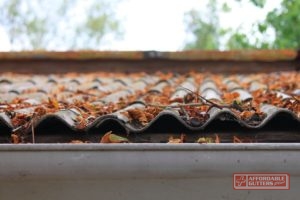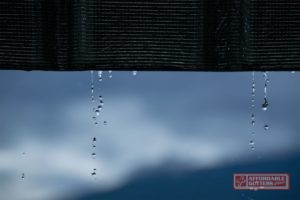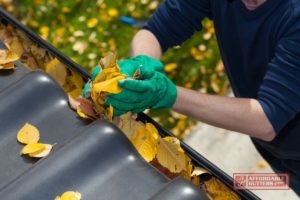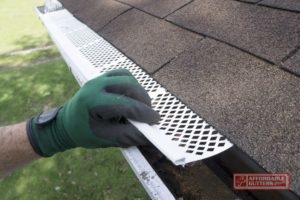
Consider gutter guards to assist in clearing out leaves & other debris!
Clogged gutters can be very detrimental to your home when they are severe. It’s important to consider the water runoff capabilities that your gutters provide in preventing water damages to the roof and foundation of your home. When rainwater has nowhere to go, it can pool in certain areas of your roof and try to find other means of escape. It can seep through the cracks of your roofing materials and if larger punctures are present than your beams could become waterlogged which poses a threat to your roof’s structural integrity! Without the tunnels of the gutters to the downspouts, water can flow down indiscriminately which in turn can cause damage to your foundation. Your gutters and downspouts naturally create a path away from the soil and concrete that your home rests on, if they are heavily wet, this could cause movement of your home and thereby your plumbing systems which are directly connected to your home and foundation. Movement can cause pressure to all sides of your pipe which heavily wears it down and makes it susceptible to breaks or soil corrosion. If ultimately your pipes burst or leaks, you can have the potential for sewer line or slab leaks that can have heavy costs in repairs. So believe it or not, the minor issue of clogged gutters can escalate and snowball into severe consequences in regards to home damages and repairs. Consider these points for the protection of your leaf guard gutters and roofing! (Energy efficient HVAC systems)
Do I need gutter guards?

Prevent gutter clogs & allow for rain water to flow naturally from your roof!
If your home resides in a region where rainfall and high winds are prevalent, or perhaps when autumn hits you often experience high levels of leaves falling, it may be beneficial to install leaf guard gutters.
What do gutter guards do?
Gutter guards act a protective and removable addition that is placed inside your gutters to catch debris. The openings are able to allow for water to seep through while it catches bigger objects like dirt, debris, and leaves. To get a better idea, you can think of some types of gutter guards as a sort of gutter colander or drain strainer.
How much are leaf guard gutters?
They range in costs between $1.50-$10 per linear foot.
Do you need to clean gutters with gutter guards?

It’s recommended to clean out your gutters at least once a year!
To go with the strainer analogy, you can remove the guard and dispose of the gunk that was caught every so often to protect the progression of natural water flow. Gutter guards are ideally designed for easier removal of gunk and should still be cleaned out every so often, at least a year unless specified otherwise.
Do gutter guards work with pine needles?
Only a few certain leaf guard gutters are able to protect against small and thin objects but most are not able to due to the size of the openings or functionings a particular gutter guard.
How are leaf guard gutters installed?
With leaf gutter guard installations, some have snaps or clips for installation while others, like plastic mesh or gutter brushes, only lay on top of the gutters. (Gutter services)
Gutter Leaf Guard Types
Perforated: perforated leaf guard gutters are made of metal and have holes distributed throughout the metal plate. Although this type of gutter guard is able to keep out leaves it’s not able to keep out more fine materials such as seeds, pods or needles. This option is prone to having small debris getting stuck in their perforated holes which increases the likelihood of overflowing due to the coverage of the opening.

Screen gutter guards are easy to install & clean out!
Screens: screens can come in different opening sizes and can be made from mesh or plastic. Fine mesh screens, for example, were specifically designed to remedy the issue of caught material often experienced with perforated metal leaf guard gutters. However, the issue with fine openings may be that they won’t be able to handle rainwater well and won’t allow them to pass through the guard and into the gutter for proper water run out. Regular mesh or plastic screens keep bigger leaves away and will let water through, but they may be susceptible to being blown off by the wind and are less likely to stop smaller objects from going through.
Brushes: bottle brushes are leaf guard gutters that are made from bristles that are inserted inside gutters and aim to prevent the accumulation of debris and leaves. Small materials aren’t able to be blocked and larger objects either get stuck in the brushes or behind them. It’s hard to remove what is trapped as the entire unit has to be removed and most report that it’s better to avoid this option entirely.
Foam: foam leaf guard gutters are made from polyurethane and are porous enough to allow for water to pass through. However, everything else just builds up on top of the foam which will clog easily if not cleaned regularly. These too require the entire guard be brought out and reinstalled for cleaning.
Reverse-Curve: reverse-curve or surface tension leaf guard gutters have been around since the early 20th century and have been proven as a good option for protection. They are designed to form a curve or nose that will allow debris to slide off the roof while water is encouraged to follow the curve and move downstream. These options are not readily available in the market and must be professionally installed. Some may lift your roof’s shingles so it’s important to select a type that isn’t prone to this occurring.
For leaf guard gutters installation in Canton, GA call 770-735-4433 with Affordable Gutters Plus LLC!
